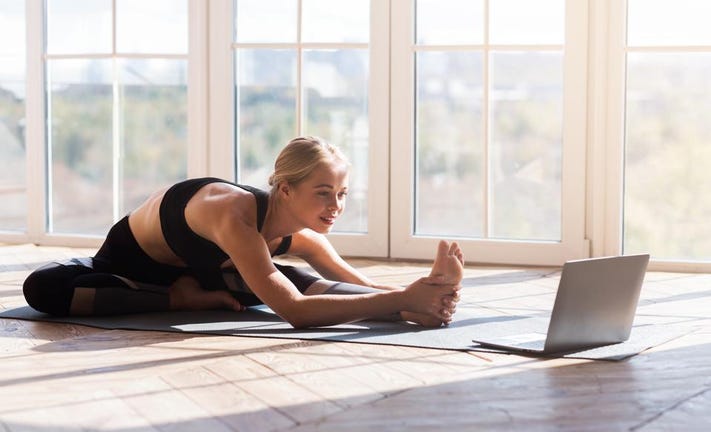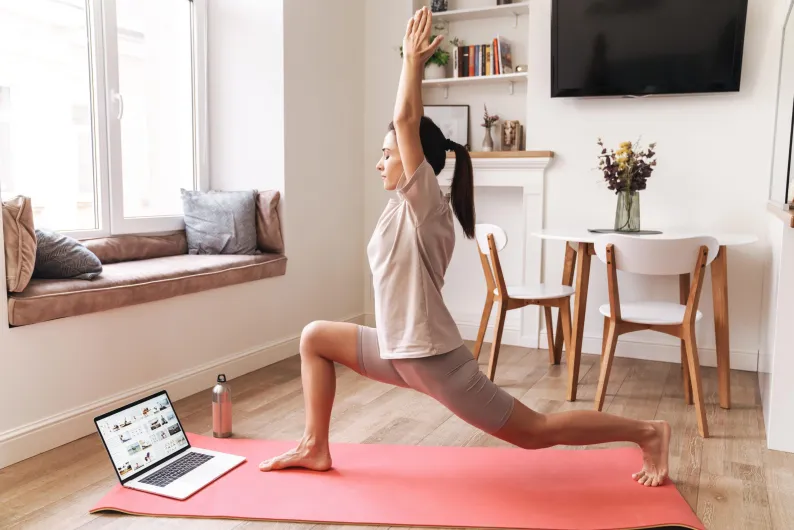Yoga Practice: Practice yoga at home, which has multiple benefits. You don't need much in the way of material and you may practice day or evening anywhere. You may easily find a wide spectrum of professors and courses at your fingertips; moreover, it's really cheap. You even accomplish it in your pjs. How to Start Yoga Practice at Home The best of all is that home yoga helps you to focus on your own body, free from concern for what other people in class are doing. It helps you to know what you need on any given day and to practice in a way that supports you both mentally and physically.
Essential Tips for Practicing Yoga at Home
1. Get a mat and collect some props
The fact that yoga requires little gear is among its finest features. A mat and accessories, however, can make some positions more comfortable. When yoga first gained popularity in the West, practitioners practiced on towels or cotton mats; it wasn't until the 1980s that "sticky mats" became increasingly popular.
The yoga mat and accessory market is growing rapidly these days and offers a broad range of options to meet practically any need. To guide your selection of the ideal mat, read our Best Yoga Mat Review. Despite taking up space and cost, you can easily substitute yoga equipment with common household items.
2. Create some areas
Try, if at all feasible, to locate a calm, serene practicing area. Though it's not necessary, having a clear wall close by might be beneficial. Some people enjoy adding candles and incense to their practice area, a picture that motivates them, or a quotation. Most importantly, you have enough room to stretch out without running into bookcases, seats, tables, etc. Working in a clutter-free environment helps you think clearly.

3. Set a time; make it reasonable
Think about what would be most suitable for you: a morning or evening person? Could you fit in some yoga during your lunch break? Regarding the "ideal" length of time to practice, disregard whether your friend practices for an hour every day or what you consider a "proper" yoga practice, and instead, focus on what works best for you. Perhaps start by committing to ten minutes of practice per day. If that would be more convenient, you may consider scheduling a specific period on a given day to block off. The secret is that it must match your life; otherwise, you won't be able to preserve it.
Read also: 7 Reasons to Slow Down Your Yoga Practice
4. Alert yourself to the three Ps
Always respect your body's boundaries, and steer clear of pining and pushing. If you recently started yoga, you might find it challenging to tell pain from discomfort. How to Start Yoga Practice at Home Though discomfort is more of a slow, persistent sensation, pain feels hot and acute. Generally speaking, stop if it falls into the joint structure (knees, spine, hips, neck, etc.). Should you experience discomfort, shift gradually rather than abruptly from the stance.
If you are uncomfortable, maybe you should soften, modify, or even employ props to help you. Before trying difficult postures, it is usually recommended to warm up adequately; furthermore, pay close attention to the transitions between positions.
5. Plan and engage in play
Attending a home yoga practice also offers the benefit of allowing you to select your class the day before, which eliminates any decision-making when you arrive on your mat. This is especially beneficial if you are attending an online class and have limited time. The night before, set up the lesson on your laptop; all you have to do is press Play.
We want to equip you with the skills to run your own regular yoga sessions so that children can incorporate these techniques into their daily routines. Whether that applies in the family house or the classroom, many times, children bring back something they have discovered to share with their households!
They enjoy showing other family members a yoga stance or lounging down for the evening with a calming breathing technique.
6. Trust the leadership your body provides
If you are accustomed to following a specific sequence or type of class, just once a week, close your laptop or book, hop on your mat, and do your own thing.
At first, this might be rather intimidating, but dismiss that persistent concern you have about not knowing what to do; yoga is not a perfectly coordinated set of positions. Either simply sit quietly or hop on your mat and squirm around for five minutes doing what feels beneficial for your body. How to Start Yoga Practice at Home Add your freeform exercise toward the conclusion of a shorter online course or sequence to build up to it.
If you would like guidance, simply stop the video before Savasana and then continue it. Yoga is any time you spend tuning in to really listen to your body and allow it to guide the path instead of your thoughts.

7. Keep it interesting
Start small by practicing a lesson or sequence that inspires you to roll out your mat. How about practicing with friends or adding some songs to your repertoire?
You might choose to commit to completing an online lesson at the same time or day every week, or you could do this physically (if social distance rules allow). You can share your experiences, and this keeps you inspired.
Read also: What Happens If a Yoga Student Gets Injured During My Class?
8. Also remember pranayama and meditation
Particularly if your studio class doesn't normally provide time for it, a home yoga practice might be a terrific chance to develop a meditation and pranayama practice. Even five minutes of ujjayi breathing combined with your asana practice can help you become more focused and calm. If you believe you are not a "meditation person," this page could help you adjust your perspective.
9. See it through
People who seek the "perfect" practice will find it nowhere! Practically speaking, try not to waste the time you set aside for yoga procrastination—that is, reading hundreds of class descriptions if you are doing an online session or skimming sequences in a book.
When you at last choose a class or series, strive to see it through unless there is a real reason to quit practicing. The monkey mind is always looking for "perfection," but whatever happens, you will learn something—about yoga or yourself.
Recognize that you often learn the most significant lessons by tackling challenges, whether they are physical or psychological.
10. Simultaneously, though, give yourself some leeway
Practicing at home can, of course, occasionally be more difficult than visiting a studio for all its advantages. It's also okay if you find time to fit your yoga practice between work and family obligations, which causes you more tension than attending an outside session. The important thing is that wherever it happens to be, you simply walk up on your mat, open, present, accepting, and inquiring.
Platform Selection
Whether the platform is free or paid, whether the search features of the platform fit our needs, if we are interested in the kind of classes provided, etc., there are other elements that define what platforms are best fit for our practice.
A home practice could be looking for several teachers, techniques, and responses to inquiries on platforms. Typically, our hobbies assist us in identifying valuable content; however, understanding the structure and features of some of these platforms is also beneficial.
How to Start Yoga Practice at Home Knowing this will enable us to locate new instructors, engage with them, and clear uncertainty about our job.

Free Sites
YouTube: With many teachers releasing fresh free yoga courses monthly, this is the largest assortment of all levels, genres, and lengths available. Usually rather explicit about where else you can find them (social media, website, etc.), teachers personalize their channel by grouping their lessons into easily available playlists.
How to Start Yoga Practice at Home Starting with a basic search (your aim or interest can help produce some viable search ideas), you may bounce to a couple of different locations in the video to see how and what the teacher is teaching.
Read also: A Practice for Increased Focus
Google: Google is a fantastic tool for looking up online yoga publications and yoga instructor websites. Here is where I go to discover solutions to certain issues (such as the best yoga mat for slippery hands or shoulder anatomy in the arm overhead pose). Most of the free articles I come across direct me to websites with extensive databases on various facets of yoga practice, including.
Over the past few years, these yoga platforms have greatly benefited me.
- The International Yoga Foundation
- Yoga Journal
- Elephant Journal
Social Media: Many teachers post their lessons and engage with their community on social media. If you want to be the first to know when your professors publish a new class, conversation video, blog article, etc., you can connect with them on all the channels they use.
Teachers typically utilize social media to expose you to the individual behind the teaching, provide behind-the-scenes peeks into their work and/or business, and solicit your opinions for what you wish to study next.
Paid Systems:
Paid platforms serve as a fantastic substitute or complement to free online learning. To help justify the cost, they can include subject-matter experts who specialize in various fields.
For example, a professional inversion teacher may create and record a handstand package over five lessons on a premium site. How to Start Yoga Practice at Home Other websites provide a more Netflix-like range of courses given by professional lecturers, concentrated on different fields. Platforms provide either monthly membership fees, a la carte pricing, or both.
Combing It All Together?
As we develop technologically, we will likely continue to have better free education and greater access to it; therefore, now is an exciting moment to begin practicing at home. Since our residence now has global access, we are no longer reliant on a teacher who lives four miles away.
Whether your interests are in considering the question "Who am I?" (which is at the core of the yoga practice) or in being hot and athletic, there are practitioners sharing the practice online and reaching audiences all across the world.
In a nutshell, the start of the yoga at home method involves:
- Find out what you would like to learn about.
- Look for similar interests on multiple platforms.
- Search for educators you wish to learn from.
- When you want to, practice as directed.
FAQ's: How To Start Yoga Practice At Home
Can I teach myself yoga at home?
An ancient and spiritual discipline with many subtleties and complexity, yoga can take a lifetime to master. If you're not on a mission to become a yogi, however, it's very feasible to study yoga on your own and develop a consistent practice that suits all the purposes you want.
10 tips to help you make the most of your home yoga practice
- Get a mat and grab some props.
- Make some space.
- Commit to a time; make it achievable.
- Watch out for the 3 Ps.
- Plan and play.
- Follow your body's lead.
- Make it fun!
- Don't forget about meditation and pranayama.
How many minutes of yoga should a beginner do?
Another way to start a daily yoga practice is to enroll in courses every day but start with five to fifteen minute sessions so that time is not a problem.